Matador Network's Blog, page 496
April 12, 2022
Mapped: The 7 Best West Coast Shipwrecks and How To See Them

Shipwrecks may be bad news for sailors, but they’re great news for travelers who love seeing abandoned places, historical sites, or places just considered especially unique.
The western coast of the United States has brought down its fair share of ships, either from poor weather, unmarked reefs, or shorelines that gained elevation just a little too quickly for older ships to avoid. On top of that, many of the best shipwrecks on the West Coast were internationally sunk (after being cleaned, of course) to create reefs for marine life.
The best thing about the West Coast shipwrecks below is that you don’t have to be a scuba diver to see most of them. Sure, some of the wrecks around San Diego will require a certification, but some of these shipwrecks are viewable from shore or easy to access if you sign up for a snorkel tour or — wait for it — an hour-long ride on a tourist submarine. In fact, seeing most of these West Coast shipwrecks won’t even require you to get your feet wet.
Oh, and if you’re more about the history and artifacts than the ships themselves, you’ll want to check out some of these area museums near the wrecks.
In California, from south to north, you’ll find the San Diego Maritime Museum, which has everything from exhibits on pirates and sea monsters to full-sized historical replicas; the Los Angles Maritime Museum, a smaller but packed museum with a huge naval history section; the San Francisco Maritime Historic Park, with rangers that sing sea shanties housed in a noted historical building; and the Humboldt Bay Maritime Museum, with a great exhibit on shipbuilding (and shipwrecking).
In Hawaii, you’ll want to visit the Bishop Museum of Hawaiian history and culture in Honolulu or, of course, the Pearl Harbor National Historic Landmark to learn about naval history and ships. In Oregon, the Columbia River Maritime Museum, Cannon Beach History Center and Museum, and the Oregon Maritime Museum in Portland tell the fascinating history of the roughly 2,000 ships sunk in the state’s waters since the mid-1700s.
The Peter Iredale
Photo: Gregory Johnston/Shutterstock

Peter Iredale, circa 1906. Photo: Puget Sound Maritime Historical Society/University of Washington Special Collections
Location: Warrenton, OregonSinking: Ran aground in 1909How to see it: Hiking/walkingThe Peter Iredale is one of Oregon’s most popular backdrops for epic photoshoots as it sits in the sand at Fort Stevens State Park and is easy to reach. When it was built way back in 1890, the ship was 285 feet long and had four huge masts to help it make long ocean crossings. It’s mostly steel, which probably explains why so much of it is still visible despite being run aground more than 100 years ago, in 1909. The ship was attempting to enter through the mouth of the Columbia River — an area known for strong waves and swells from the river water colliding with ocean water. Add in low light, strong winds, and a bit of fog, and it’s not surprising that the ship ran aground in its current location. Unfortunately, the weather didn’t subside very quickly, and the Peter Iredale was too far buried in the sand by the time conditions were favorable enough to salvage the ship.
That was bad news for the ship’s owners but great news for visitors, who can see the shipwreck by taking just a quick walk from the park’s parking lot. Go at low tide, and be prepared to wait for a while if you want the beach to yourself for photos — it’s a popular spot.
By the way: the area around the Columbia River is known as the “Graveyard of the Pacific” due to how many ships crashed in the hard-to-navigate waters. In 2022, most of the Columbia River Maritime Museum will be devoted to a huge exhibit on shipwrecks, which should be on view for at least a few years.
The YO-257
Photo: Jeff Whyte/Shutterstock

The YO-257 looked similar to this Big Horn Class oil tanker. Photo: US Navy/Public Domain

Photo: @Ash Underwater
Location: Off Waikiki Beach, Oahu, HawaiiSinking: Intentional, 1989How to see it: Scuba diving, submarine tourThe YO checks a lot of boxes when it comes to shipwrecks. It’s large, fairly intact, and easily accessible even if you don’t dive. Amazingly, you don’t even have to get wet. The YO was sunk intentionally by Atlantis Submarines, a company that runs submarine tours in Waikiki. The YO is a former oiler for the US Navy and is about 175 feet long, sitting about 75 feet deep at its shallowest point and 115 feet at the deepest. It’s a hugely popular site for scuba divers, so don’t be surprised if you see divers on the ship (or, if you’re a diver, don’t be surprised if a submarine comes out of the water and starts circling you). The water visibility is pretty good at an average of 80 feet, though, of course, the deeper you go, the murkier it gets.
The YO served in World War II and the Korean War, but it ended its career in one piece. After being thoroughly cleaned to ensure it wouldn’t pollute the ocean, it was dragged out to its current site and sunk in 1989. In addition to coral and schools of tropical fish, visitors can usually see large sea turtles around the bow.
The SS Palo Alto
Photo: Eleni Mavrandoni/Shutterstock

Trial run of SS PALO ALTO at Oakland California on 10 September 1920. Photo: Naval History and Heritage Command/Public Domain

Photo: anderm/Shutterstock
Location: Aptos, CaliforniaSinking: Abandoned early 1930sHow to see it: Hiking/walkingThe next time you’re in Santa Cruz relaxing on the beach, you may want to take a closer look at the long pier at the end of Seacliff State Beach. Because the end of the pier isn’t just a prime fishing spot — it’s the site of a 420-foot-long ship built as an oil tanker for WWI. The war actually ended before it was finished, however, and it was quickly sold to a nightlife company, who turned it more or less into the 1920s version of a party ship, complete with bars and a swimming pool. But that company went belly-up during the Great Depression, and the SS Palo Alto just stayed there. Locals used to fish from it until the 1950s when it was closed for safety issues.
Today, the Palo Alto is slowly falling apart due to waves and heavy storms, though it’s still quite visible (but in several pieces). Obviously, you’ll be able to see the ship best at low tide. It’s usually covered in sea birds and it’s not unusual to see sea lions and seals swimming around the ship. The visitors center at Seacliff State Beach has an exhibit on the history of the ship and surrounding marine ecosystem, since the whole area is part of the Monterey Bay National Marine Sanctuary.
The Ruby-E
Photo: @Ash Underwater

The USCGC Cyane was a Thetis class Patrol Boat, likely very similar to this one (the USCGC Ariadne). Photo: United States Coast Guard/Public Domain

Photo: @Ash Underwater
Location: San Diego, CaliforniaSinking: Intentional, 1989How to see it: Scuba divingMost people who want to see wrecks in San Diego head to the well-known HMCS Yukon — a fantastic dive — but the less-visited Ruby E is no less impressive. The Ruby E started its life as the USCGC Cyane in 1934. It was built to be long and fast and could travel up to 16 knots to pursue rum runners and other ships trying to smuggle in alcohol during Prohibition. Though Prohibition ended at the end of 1933, the ship continued to chase smugglers trying to avoid taxes until 1937, when it was sent to Alaska for a few years before serving in Japan in WWII. It was decommissioned in 1950 and sold to a privately owned fishing company, then to a company or two in South America, before coming back to San Diego and being renamed The Ruby-E. The owners soon donated it to San Diego’s Wreck Alley and, after it was cleaned, it was sunk in July of 1989.
Ironically, given its history of chasing smugglers, the Ruby-E had secret compartments, presumably used for smuggling drugs in the 1970s and 80s. When they filled with water, it tilted the ship, causing it to sink exceptionally quick and land at a slight angle in its current location.
Today, the Ruby-E sits in water between 65 and 85 feet deep. Because of occasional currents, cold water, and poor visibility, it’s a slightly challenging dive, though advanced certifications aren’t required to stay near the upper parts of the bow. Advanced divers can swim through multiple rooms within the ship.
The YOGN-42
Photo: Dai Mar Tamarack/Shutterstock

Photo: United States Navy Photo/Public Domain

Photo: Lynn Yeh/Shutterstock
Location: Lana’i, HawaiiSinking: 1950, intentionally beached for reasons unknownHow to see it: Hike/ATV combo or snorkel tourLaunched in 1943, the 375-foot-long YOGN-42 served its first years supporting the Allied efforts in WWII, primarily around Japan and Oceania. It served more or less without incident, save for when the ship towing it was struck by a Japanese torpedo– but the YOGN-42 wasn’t damaged. However, it was decommissioned in 1949 for reasons unknown and sunk about a year later in its current location. It looks like a bit like a ghost ship, mostly because it sits several stories above the waterline, giving the impression that it’s still afloat.
If you’re on Lana’i, you can see it if you’re willing to rent an ATV and follow some rough roads out to the approximate location. But the easiest way to see it is to sign up for a snorkel tour that’ll take you out to the impressive shipwreck by boat. Just look for a snorkel tour that goes to Shipwreck Beach, an eight-mile stretch of sand whose offshore reefs have caused the downfall of more than a few ships. The other notable ship along the stretch of beach is the YO-21, an oil tanker that was a Pearl Harbor on December 7, 1941 — though it’s a good six miles on foot from the YOGN-42.
The HMCS Yukon
Photo: @Ash Underwater

Photo: /Canada.ca

Photo: @Ash Underwater
Location: San Diego, CaliforniaSinking: 2000How to see it: Scuba divingThe HMS Yukon is probably the most well-known shipwreck in San Diego’s Wreck Alley. As you may be able to guess from the name, it was a Canadian ship named after the Yukon River. It was built to be a destroyer — a ship that goes on the offense to protect larger gunships during marine warfare. But it didn’t see much combat and only served until 1993. In 2000, a San Diego-based ocean protection organization bought it and cleaned it to sink as an artificial reef. However, the Yukon technically wasn’t intentionally sunk, as it flooded and sank on accident during a storm one day before its scheduled sinking. Unfortunately, that threw the ship’s location off a bit, and the shallowest part of the 366-foot-long naval ship is still at a depth of 60 feet. The bulk of the ship sits between 80 and 100 feet deep.
Combine those depths with San Diego’s cold water, iffy visibility, and not-infrequent ocean surges and currents, and it’s no surprise that visiting the Yukon is for advanced divers only. And entering the ship — which has several levels and dozens of rooms, most of which are pitch black — should be attempted only by very experienced divers familiar with ceilings and directional navigation.
“Sauce Bros” Barge
Photo: elakazal/Shutterstock
Location: Salinas, CaliforniaSinking: ?How to see it: Hiking/wadingJust south of San Francisco sits a massive barge just off the Salinas River Wildlife Refuge coast, but that’s about the extent of all anyone knows about it. It’s a barge, and it’s there. The hike to see it is about 1.5 miles north of the sanctuary. Most people say it’s been there since the early 1980s, though others say it washed up in large storms in 1995. Other than the fact that it says “Sauce Bros” on the side, it’s anyone’s guess what the ship’s history is.
You can walk to the barge at low tide, though it’s visible to some extent usually all the time, except for when the tide levels are especially high. 
More like thisArt + Architecture45 Eerie, Creepy, and Often Beautiful Abandoned Places Around the World
These 8 US Airports Were Among the 10 Busiest in the World in 2021

The vast majority of the world’s busiest airports in in 2021 were in the United States. According to the most recent Airports Council International report, the top 10 airports in the world saw 463 million passengers in 2021. Eight of the top 10 were in the US.
The world’s top 10 busiest airports by number of travelersHartsfield-Jackson Atlanta International Airport: 75,704,760Dallas/Fort Worth International Airport: 62,465,756Denver International Airport: 58,828,552O’Hare International Airport in Chicago: 54,020,399Los Angeles International Airport: 48,007,284Charlotte Douglas International Airport: 43,302,230Orlando International Airport: 40,351,068Guangzhou Baiyun International Airport: 40,259,401Chengdu Shuangliu International Airport: 40,117,496Harry Reid International Airport in Las Vegas: 39,754,366This is the first time Orlando has made the list since travel numbers started to be documented in 1991, according to TravelPulse. Dallas/Ft. Worth also saw a big move going up from the 10 spot in 2019. And though travel has been coming back in fits and starts, overall airport traffic is down by 18 percent compared to 2019.
While it’s a sign that people are more than ready to start traveling in the US again, it’s also led to lots of flight cancellations and frequently delayed airlines as the industry works to get back up to speed. Major US airlines are cutting planned summer flights by as much as 10 percent. Prices increased about 40 percent from January to March, and are expected to only get higher.
It’s not just the airlines, of course. Airport staff have felt the tourist crunch as well with some of the longest security line wait times found at busy hubs like Miami (about 47 minutes average time to get through security) and O’Hare (about 40 minutes on average).
This has led some changes to how people book travel. The optimum window for the cheapest flights, for example, has shifted to 21 to 127 days in advance.
Make sure to follow these tips for getting through TSA airport security faster, and look for the best frequent flyer program for you or use this Google Flights hack to get the best prices on flights. If you do find yourself stuck waiting, it might be worth it to pay for Priority Pass to gain access to 1,300 airport lounges around the world.
Experience the Best of Coastal Life at These Top-Rated Virginia Beach Airbnbs

With its atmospheric promenade, buzzing ViBe Creative District, and ocean-fresh shellfish, Virginia Beach is the place to go this summer. But where to stay near Virginia Beach Boardwalk to experience all the delights of this seaside resort? Rather than spend all your time surfing the web when you could be chasing your next wave, peruse our selection of the coolest Virginia Beach Airbnb rentals.
Top Pick of Virginia Beach AirbnbsAirbnb Virginia Beach oceanfront vacation rentalsAirbnb Virginia Beach with poolWe hope you love the Virginia Beach Airbnb rentals we recommend! Just so you know, Matador may collect a small commission from the links on this page if you decide to book a stay. Listed prices are accurate as of the time of publication. See our full Advertiser Disclosure here.
Top Pick of Virginia Beach AirbnbsThe Old Salt
Photo: Airbnb

Photo: Airbnb

Photo: Airbnb
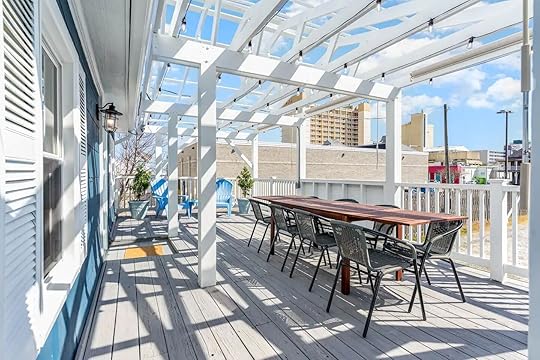
Photo: Airbnb
Renovated in 2021, this cute vacation rental was built in 1910. Contemporary interiors are minimalistic but nod at a shoreside theme with maritime relics and artworks. A partially covered terrace awaits you on the second floor where you can sip your morning brew (or linger over a homemade mojito in the evening). Best of all, this Virginia Beach Airbnb is fitted with a generous stash of bodyboards for guests to grab and go.
Six guests, three bedrooms
Price: $300 per night

Photo: Airbnb

Photo: Airbnb

Photo: Airbnb
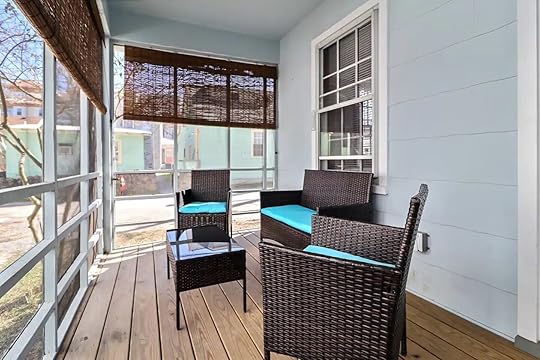
Photo: Airbnb
This chic beach house is one of the best pet-friendly vacation rentals in Virginia Beach. Perfect for families, the property features a master bedroom plus a room fitted with a double and a bunk bed – perfect for that slumber party vibe. The interiors have ample space for spreading out while the backyard comes with a barbecue for casual family dinners. It’s super central; you can walk to the boardwalk and ViBe without breaking a sweat.
Six guests, two bedrooms
Price: $290 per night

Photo: Airbnb

Photo: Airbnb

Photo: Airbnb
This desirable North End Virginia Beach Airbnb with a hot tub is impeccably presented with an open-plan kitchen and lounge and four spacious bedrooms. Your private terrace is fitted with a beautiful seating area and a bubbling spa bath. Although you might not see the ocean from the property, rest assured that you’ll hear it. The beach is a five-minute walk away.
Nine guests, four bedrooms
Price: $725 per night

Photo: Airbnb

Photo: Airbnb

Photo: Airbnb

Photo: Airbnb
This kooky rental in the ViBe neighborhood strikes a balance between home comforts (think fireplaces and Chesterfields) with seaside embellishments. Bicycles and surfboards are available for guest use and there is a billiards table for fun nights in. One of the homeliest luxury vacation rentals in Virginia Beach has to offer families and groups of friends.
Eight guests, three bedrooms
Price: $390 per night
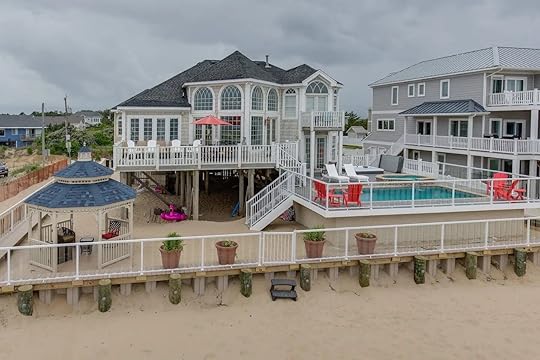
Photo: Airbnb

Photo: Airbnb

Photo: Airbnb
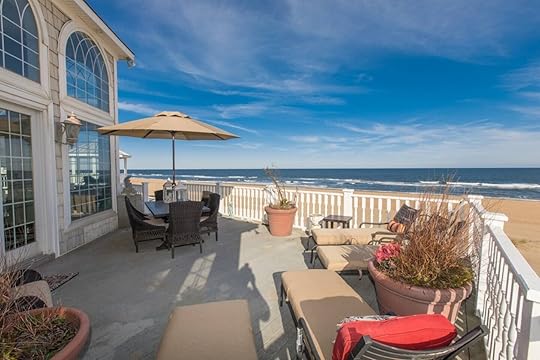
Photo: Airbnb
This opulent vacation home in Sandbridge, South Virginia Beach, sets out to impress with its monumental windows, chandeliers, fireplaces, and period furniture. A verandah overlooks the beach and provides ample space for dining and sunbathing. The lower level of the patio has two swimming pools connected with a waterfall feature as well as a hot tub. You’d struggle to find pet friendly vacation rentals in Virginia Beach as lavish as this one!
Twelve guests, five bedrooms
Price: $1,250 per night
Book here
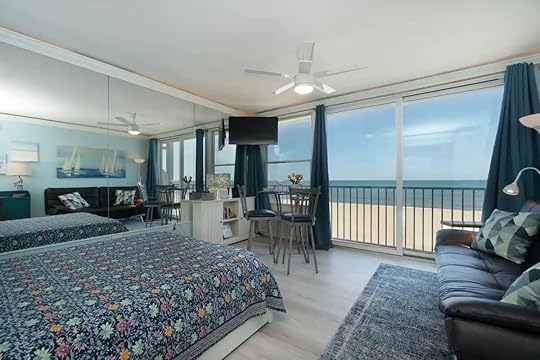
Photo: Airbnb

Photo: Airbnb

Photo: Airbnb
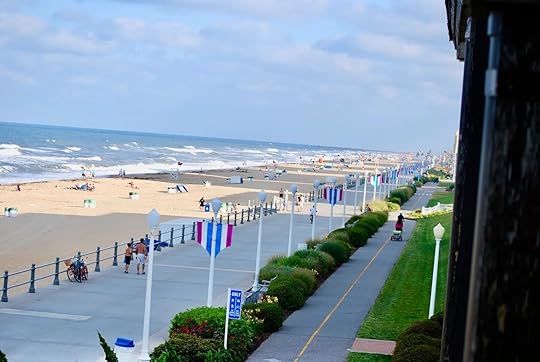
Photo: Airbnb
Ogle the Atlantic Ocean from bed at this beachfront Airbnb in Virginia Beach. Floor-to-ceiling windows and a Juliette-style balcony capitalize on the views. Awesome for a couple, the studio is equipped with a kitchenette and dining table overlooking the water. You’ll have access to a shared pool and the private lawn leisure area during your stay at this centrally-located condo.
Two guests, one bedroom (studio)
Price: $210 per night

Photo: Airbnb

Photo: Airbnb

Photo: Airbnb

Photo: Airbnb
This sophisticated condo is ideal for those seeking Virginia Beach oceanfront vacation rentals that merge the convenience of downtown with a quiet setting. Located steps away from the sand near the Rudee Inlet, this homely residence comprises two double rooms and two bathrooms. The balcony is perfect for a sundowner.
Five guests, two bedrooms
Price: $230 per night

Photo: Airbnb

Photo: Airbnb

Photo: Airbnb
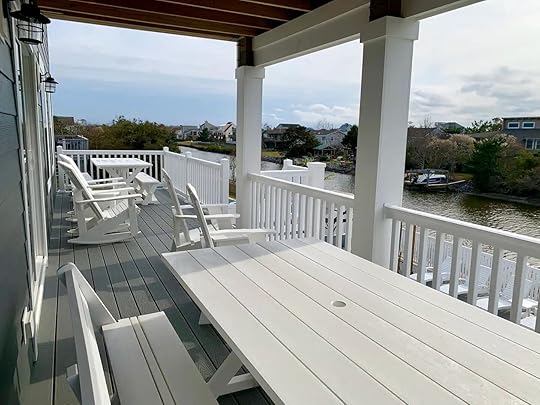
Photo: Airbnb
Located in tranquil Sandbridge, this supersized vacation rental has bags of space to congregate with your loved ones or snatch an afternoon of solitude. Spanning three levels, this family-friendly Airbnb at Virginia Beach has the added perk of a gym and kids’ playground. A private backyard overlooks the canal and contains a sundeck and private pool.
Sixteen guests, eight bedrooms
Price: $1,200 per night

Photo: Airbnb

Photo: Airbnb
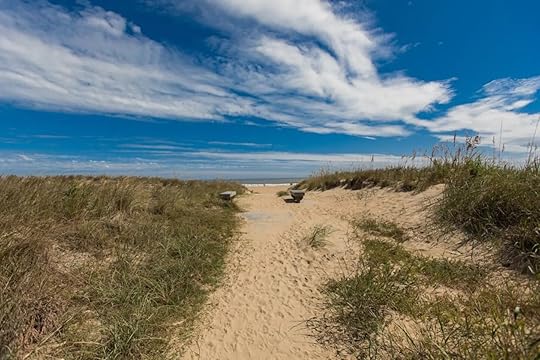
Photo: Airbnb

Photo: Airbnb
Situated in the North End, this Airbnb Virginia Beach with a pool consists of two properties that share a backyard. There are four bedrooms in the main house with an additional two beds, two bathrooms, a kitchen, and a lounge in the adjacent guest house. There is tons of light thanks to the plentiful windows and glass porch and a large fireplace for cozy nights in.
Twelve guests, six bedrooms
Price: $750 per night

Photo: Airbnb

Photo: Airbnb

Photo: Airbnb

Photo: Airbnb
In terms of where to stay near Virginia Beach Boardwalk in the heart of the action, you can’t beat ViBE. This modern home is mere blocks from the beach and cultural attractions this neighborhood is famed for. But, with a private pool, large backyard, and gorgeous interiors, you might be tempted to spend the whole trip making the most of this cracker of an Airbnb.
Ten guests, three bedrooms
Price: $470 per night

Photo: Airbnb

Photo: Airbnb

Photo: Airbnb

Photo: Airbnb
Our final pick of luxury vacation rentals in Virginia Beach ticks all the boxes. The vast beach house is the vacation home of the host and it chimes with homely touches, particularly in the children’s bedroom. There is a pool, a roof deck with a barbecue, and access to a private beach. Subject to a surcharge, dogs are welcome at this lovely family home near the Rudee Inlet. 
Fifteen guests, four bedrooms
Price: $525 per night
Nebraska Has One of the Largest Animal Migrations on Earth. Here’s Everything To Know.
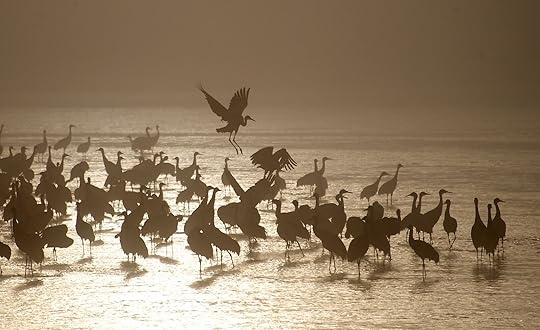
Most people know what animal migrations are — incredible phenomena when animals shift habitats based on weather and seasons in huge groups. But how many people can say they’ve witnessed one? With millions of animals migrating seasonally in search of food, better climates, and mating opportunities, the chance to experience the natural wonder of migrations might be closer than you think – and it’s not just whales and other well-known species migrating through tropical locations, either. A fascinating migration happens to be smack-dab in the middle of America. In fact, the migration is North America’s largest and occurs in one place only: Nebraska.
The annual sandhill crane migration
Photo: Brian Lasenby/Shutterstock
The sandhill cranes in Nebraska are the stars of one of the last great migrations on Earth and one of the largest in North America. According to David Baasch, wildlife biologist and threatened and endangered species specialist at The Crane Trust, roughly one million cranes stop in or around the Platte Valley during their migration. That’s around 80 percent of the world’s sandhill crane population, which makes it one of the largest animal migrations in the world by percentage of population, at least among species with vertebrae.
The cranes stop along the Platte River Valley to rest and refuel from late February to early April. The cranes have been traveling the same migratory route for thousands of years, leaving their wintering grounds down south and heading north to their breeding grounds. That’s almost as large as the famous wildebeest migration in Tanzania and Kenya each year.
Sandhill cranes are medium-sized birds that can get up to four feet tall with a wingspan of six feet. Stunningly, they can travel up to 450 miles per day at speeds of 38 mph. They’re monogamous and lay just one or two eggs a year. With a lifespan of 25 years, it is not uncommon to see generational flocks migrating together year after year.
Why Nebraska?
Photo: marekuliasz/Shutterstock
Rural Nebraska’s Platte River has served as a migratory route across the continent for humans and animals alike for millennia, and the 80-mile stretch of the Platte River Valley is the last area of the Great Plains that meets the sandhill crane’s needs. The shallow channels create safe roosting sites while the nearby farms and wetlands provide ample food. The opportunistic birds gain approximately 15 percent of their body weight while in Nebraska.
Reaching the sandhill cranes in NebraskaThe easiest way to reach Nebraska is to fly into Grand Island or Lincoln. You’ll then want to rent a car to explore a few different cities and move at your own pace as you watch and photograph the cranes. That said, the Sandhill cranes in Nebraska aren’t hard to find. You’ll see large groups in cornfields on the sides of the highways, and there are many public access areas for crane viewing you can visit at your leisure.
Sandhill crane migration tours
Photo: Rowe Sanctuary
There are several ways to witness the crane migration, and you’ll be surprised at how easy it is for travelers of all ages to snag front-row seats. While it’s fun to road trip around the area on your own, you’ll gain insight from biologists and avian experts if you go with a guided tour. It can be fun to sign up for a sunrise or sunset tour or full-day field tour if you have the time.
Luxury travelers may like traveling with the Crane Trust, a non-profit that runs photography camps and all-inclusive overnight tours, which include lodging, meals, and two 90-minute crane viewings at sunset and sunrise. They have heated viewing blinds, perfect for sunrise photography when you can see the cranes waking up. They’re noisy, and it sounds beautiful. By the time the sun is up, most cranes have flown off in flocks of thousands to their daytime hangout in the harvested cornfields. It’s a truly magical experience. There’s also a bison heard on the property, which is worth visiting.
Another good viewing area for the sandhill cranes in Nebraska is the Iain Nicolson Audubon Center at Rowe Sanctuary, located in Kearney, a medium-sized town known as the “sandhill crane capita of the world.” The sanctuary offers guided trips during the Sandhill Crane migratory months, which includes an educational presentation and a 90-minute viewing in a heated blind (great for those chilly nights and early mornings). As the sandhill cranes come in from the fields at sunset, you’ll have the chance to see how they line up in family groups on the water before settling down for the night. Since they roost along the river, sunset and sunrise viewings provide the best opportunities for photographing them in large groups.
Check out Dusty Trails Outdoor Specialists in North Platte, Nebraska if you’re more adventurous. Dusty offers a sandhill crane bus tour that gives viewers the chance to observe the cranes in the cornfields as they feed and practice their dancing skills.
Yes, dancing.

The tall birds’ “dance” moves are fascinating to see in person. Photo: Julana Dizon
Sandhill cranes bow to each other, flap their wings, and jump as a way of communicating, courting, and mating. Pairs that mate for life often dance together to strengthen their bond.
The tours are on a school bus, and Dusty is full of educational and fun facts about life in the Midwest. If you’re lucky, Anne (his Australian cattle dog) will come along for the ride.
Tips for viewing the sandhill crane migrationA big part of having an enjoyable crane viewing trip is being prepared. Bring binoculars, your best camera, shoes you don’t mind getting muddy, and layers for warmth — expect mornings to be very cold. You may also want something waterproof to sit on.Try to spend at least two days focused on crane watching to account for factors outside your control, such as weather. Most tours get great views of the cranes throughout the season, but the weather does tend to affect how the cranes behave.If you can’t make it to Nebraska but still want to see the migration, you can always watch the progression online via the live “Crane Cam” at The Crane Trust and Rowe Sanctuary. The best time to watch is in late March when the number of cranes will be highest.
More like thisWildlifeThe Most Spectacular Animal Migrations Around the World and Where To See Them
Find This Whiskey Company’s Gold Cup Out in Nature and You’ll Win $10,000

TINCUP Whiskey is hoping to inspire people to get outside this year for a whiskey themed scavenger hunt with a $10,000 prize.
Called the “Spirit of Adventure,” the search is for three special edition gold-plated versions of TINCUP’s iconic cups that top the whiskey bottles. You won’t find them in a liquor store, though. In fact, each bottle was hidden in a different place in the great outdoors by a noted outdoor adventurer: Paulina Dao, an adventure lifestyle photographer; Max Djenohan, a professional primitive survivalist from Naked and Afraid; or Caite Zeliff, a professional skier and paraglider.
It might seem impossible to find three gold cups hidden across the country in anywhere that classifies as outdoors. But if you do stumble across one of the gold cups, you’ll be paid handsomely with a $10,000 finders fee. To help, clues will be released every few days on the company’s Instagram page until each of the cups is found.
View this post on InstagramA post shared by The Mountain Whiskey (@tincupwhiskey)
“Adventure is at the heart of TINCUP Whiskey, which is why we wanted to find a way to inspire exploration across the country and share that enthusiasm with our community,” said TINCUP founder Jess Graber in a statement. “We’ve teamed up with some very notable explorers to help hide our beloved gold cups and we can’t wait to see toasts with TINCUP after a day well-spent exploring.”
The search begins on April 15 at 9:27 AM PST. You can sign up for alerts when new clues drop, or follow along on Instagram. 
11 All-Inclusive Beach Resorts in Mexico for Under $300 a Night

Because they are affordable and easy to access from the US — direct flights are rarely more than four hours, dropping you down into paradise by lunchtime — a beach resort in Mexico is the perfect vacay. But just because all food and drinks are included does not mean you need to plunk down $1,000 per night to stay at some of the best all-inclusive resorts in Mexico.
From the Pacific Coast to the Caribbean Sea, some all-inclusive resorts in Mexico charge a more affordable rate — under $300 per night — but still include more than one restaurant, on-site entertainment, a pool, killer views and a beachfront setting to make your time on the property so blissful you may never want to leave. Whether you’re booking a family-friendly trip or a romantic getaway, here are 11 all-inclusive beach resorts that offer a lot of value — without the high cost.
We hope you love the spaces and stays we recommend! Just so you know, Matador may collect a small commission from the links on this page if you decide to book a stay. See our full Advertiser Disclosure here.
The Fives Beach Hotel & Residences, Playa del Carmen
Photo: Booking.com

Photo: Booking.com

Photo: Booking.com
Rooms at this 662-room beachfront resort are not typical all-inclusive décor: think modern art and clean lines. Ten restaurants (from Thai food in a funky wallpapered dining room with a larger-than-life Buddha statue to an adults-only Peruvian-meets-Japanese raw bar) and four bars (including a swim-up bar and a high-design Mexican cantina with live folk and mariachi music) make this a destination for foodies. A beach club, seven outdoor pools, a fitness center and manicured gardens provide other spots to unwind.
Grand Oasis Palm, Cancun
Photo: Booking.com

Photo: Booking.com
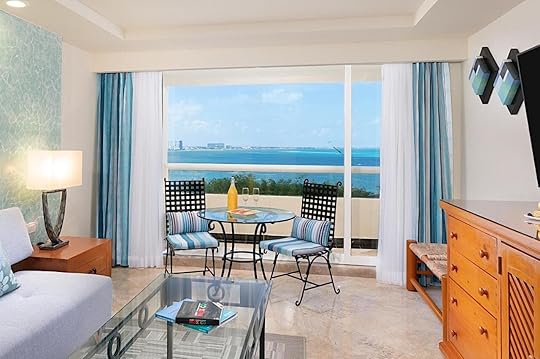
Photo: Booking.com
Tucked into Cancun’s Hotel Zone the 470-room beachfront property on a private beach features a spa with massage cabins, multiple outdoor pools, and a kid’s club with enough immersive activities to keep the little ones happy, plus an arcade and the Yucatan Jurassic River. Sixteen restaurants, including The White Box, serving molecular gastronomy in a house-like eatery on the beach, are joined by nine bars. Despite being family-friendly there are also adults-only zones — like a nighttime pirate-ship tour. Keep your eyes peeled for wine, tequila and mezcal tastings for even more fun.
Solmar Resort, Cabo San Lucas
Photo: Booking.com

Photo: Booking.com

Photo: Booking.com
That the 100-room resort’s a five-minute walk from downtown Cabo San Lucas means you can easily check out taco stands, art galleries and boutiques, and the marina — all on foot. Thankfully it’s also on the beach, nearly secluded behind granite cliffs, a plus if you book a massage in the spa’s private cabanas. There is also a pool right on the beach and an adults-only pool, too. For meals, choose from three restaurants serving barbecue, Mexican, sushi and international-fusion fare, along with a swim-up bar. Staff do a good job of cultivating a fun calendar of events, including themed nights.
Dreams Acapulco Resort & Spa, Acapulco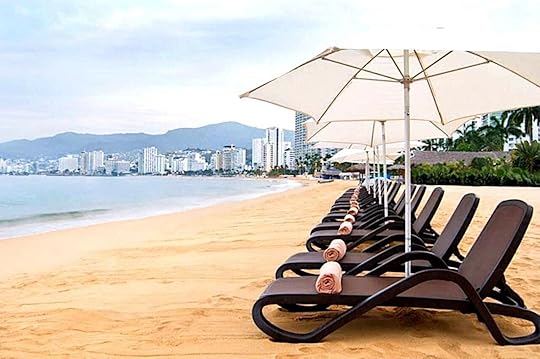
Photo: Booking.com

Photo: Booking.com

Photo: Booking.com
Open since 2019, what sets this 605-room resort apart is not the Acapulco Bay location, but the off-beat interior design, such as tiles in vintage hues of turquoise and mauve. A full roster of activities is available, from beachfront yoga to sport fishing, as well as live musical performances at night and two outdoor pools to enjoy. Kids and teens clubs ensure everyone in the family is kept busy and made happy. Choose from seven dining options that leave nothing undesired — such as a buffet, coffee shop, ice-cream stand, multiple pools and beachfront bars, and eclectic dining from grilled seafood and steaks to hearty pasta dishes for dinner.
Krystal Grand Los Cabos, San Jose del Cabo
Photo: Booking.com

Photo: Booking.com

Photo: Booking.com
Only a quick seven-minute car ride from the artsy, vibrant town of San Jose del Cabo, Krystal Grand’s 429 rooms frame views of the Sea of Cortez or the resort’s manicured gardens. Three specialty restaurants focused on Pan-Asian, Teppanyaki, Mexican and Italian join an all-day buffet and plenty of bars, each focused on different beverages. Four pools, movie nights, yoga classes, game rooms, themed parties, fitness centers and for those traveling as a family — kids and teens clubs and a waterslide at the kid’s pool means you’ll never get bored.
Melia Puerto Vallarta, Puerto Vallarta
Photo: Booking.com
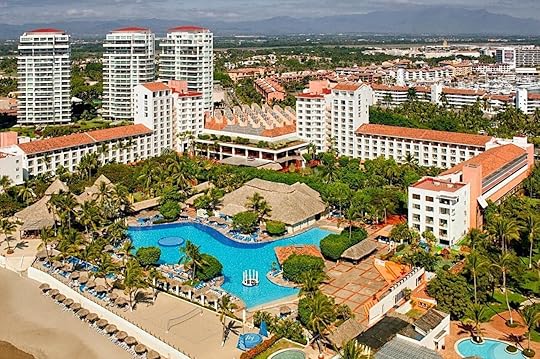
Photo: Booking.com

Photo: Booking.com
In addition to the usual all-inclusive amenities at this family-friendly all-inclusive — pools, multiple restaurants and bars, and a beach — there are also three that are rare: a rock-climbing wall, an archery gallery and a weekly night market where artisans sell their crafts. While it’s a five-minute jaunt to the airport this property also rims the coast, giving you access to both. Four restaurants, including a breakfast buffet and a lunch buffet, a lobby bar, a swim-up bar and a palapa bar, plus a lagoon-style pool are also on-site.
Grand Palladium Vallarta Resort & Spa, Punta Mita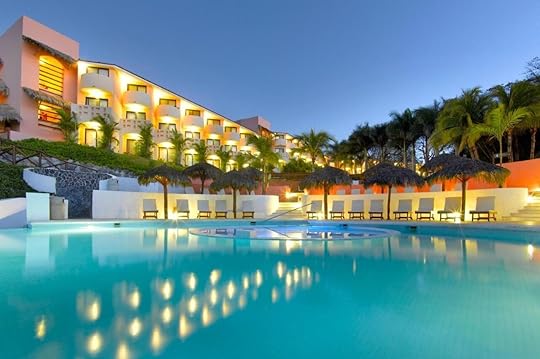
Photo: Booking.com

Photo: Booking.com

Photo: Booking.com
The cliffside setting of this 518-room resort translates to amazing views, whether you’re kicking back at one of the five pools (one boasts a kid’s waterpark while another is “the quiet pool”) or relaxing on a private balcony. Zentropia Spa & Fitness Center caters to wellness-oriented travelers while the orchid garden cultivates a sense of calm. Ten bars and five restaurants such as sushi at Bamboo, wood-fired pizzas at Portofino, or a taste of Mexico at La Adelita are options for guests, including a swim-up and beachfront bar.
Marival Emotions Resort & Suites, Riviera Nayarit
Photo: Booking.com

Photo: Booking.com

Photo: Booking.com
Right on Nuevo Vallarta Beach, in the Riviera Nayarit Complex, each of the 495 rooms of Marival Emotions Resort flaunt a private balcony. Interior design and cuisine at each of the six restaurants and seven restaurants are contemporary, such as bright-yellow dining chairs at Amalfi or surf-and-turf at La Bamba, just steps from the sand. What this all-inclusive has that not all do is a nightclub. Many guests keep the night going after a show at Miraval theater, live piano music at the martini bar, or by heading to Cesar Night Club for drinks and dancing. Intra Mare Spa’s treatments fold in little luxuries, such as “Champagne cream” in one massage service and hot stones in another.
Cozumel Palace, Cozumel
Photo: Booking.com

Photo: Booking.com

Photo: Booking.com
Anchored by its stunning infinity-edge pool that appears to spill right onto the beachfront, this 175-room hotel comes with a huge perk: access to sister hotels in Cancun (except Le Blanc). This widens the options for dining as well as different pool views. A short ferry ride connects the two regions. Divers flock here because some of the world’s best diving spots are nearby. Or, you can snorkel right off the resort’s dock. An onsite spa for pampering, four restaurants, nightly fire and karaoke shows, and a kids club packed with fun activities are other amenities.
Sunscape Dorado Pacifico Ixtapa Resort & Spa, Ixtapa-Zihuatanejo
Photo: Booking.com

Photo: Booking.com
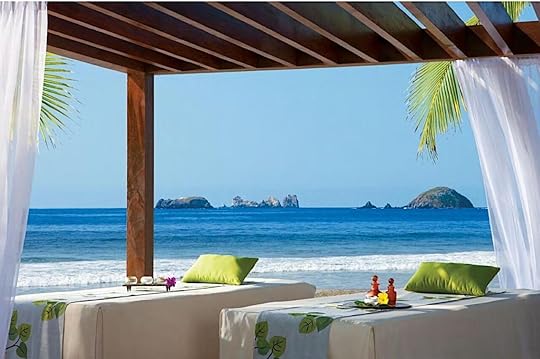
Photo: Booking.com
For travelers with extreme adrenaline, one of the outdoor pools at the Sunscape features five waterslides to zip down. Then, at another pool is a swim-up bar so you can put in a few laps before relaxing with a drink. Night owls love to dance the night away at Starlight Lounge. Forget something at home? A shopping center is connected to the resort. Of the six dining options is a food truck called The Snack Machine for casual meals on the go as well as Tamarindo’s high-end Mexican fare for date night, or a private dinner for two set up on the beach.
El Cid Marina Beach Hotel, Mazatlan
Photo: Booking.com

Photo: Booking.com

Photo: Booking.com
With the Golden Zone Marina and a private beach just outside this 210-room all-inclusive’s doors, you get the best of both worlds in terms of views. At the two pools are a swim-up bar and underwater caves, a unique add-on you don’t normally find at resort pools. A spa is also on-site. For guests who like to golf, there is a complimentary shuttle service to El Cid Golf & Country Club. While there are only two restaurants, La Terraza, entirely outdoors; and the seafood-focused La Marina Restaurant & Bar, both are open for all three meals of the day. Plenty of restaurants are also within walking distance. 
April 11, 2022
Meaning of hand signs abroad

Travelers who visit foreign lands and who don’t have a good grasp of the local language often rely on hand signs to make themselves understood. But if you want to befriend the locals or just avoid angering everyone around, you should watch their hands very carefully. What may seem like an innocuous hand gesture in North America can have severe social consequences abroad. While pointing with an index finger seems to be rude everywhere in the world, most hand signs meaning vary widely from country to country — a simple thumbs-up or even crossed fingers can land you in hot water.
This guide to hand signs meaning in foreign countries will help you stay polite when abroad — or teach you how to make your point in a bad-mannered, and sometimes obscene, way if that’s what you’re after.
Insulting hand gesturesBackwards peace sign in the UK, Ireland, New Zealand, and Australia
Photo: Cubankite/Shutterstock
While making a V with you index and middle finger is a sign of victory, if turned backwards, it is the nonverbal equivalent of “up yours” in the UK, Ireland, New Zealand, and Australia.
Holding your palms out in GreeceWe use this gesture in North America to say “stop,” or, if you’re childish and petulant “talk to the hand.” In Greece, however, holding your palms out towards a person is a highly insulting gesture known as the Moutza. This gesture is said to be a remnant of Byzantine times, when people could taunt shackled criminals by smearing their faces with excrement.
Thumbs-up in Thailand and the Middle EastThis gesture of agreement or approval is an easy reflex when language barriers are at play. Try to avoid it in Thailand, though, where it’s a sign of condemnation. It’s typically a child’s gesture, the Thai equivalent of sticking out your tongue. People will likely be more bemused than hurt if you slip up. Still, it’s a good one to avoid.
In the Middle East, a thumbs-up gesture means “up yours”, the equivalent to the North American middle finger gesture.
Beckoning in the Philippines
Photo: ViDI Studio/Shutterstock
Curling your index finger to say “come here” is a no-no in many Asian countries, including in Singapore where it is said to symbolize death.
In the Philippines, this gesture is only used for dogs. To use it with a person is derogatory; suggesting that you see them as a subservient inferior.
In Japan, the come-hither hand sign is highly offensive too. The Japanese way to beckon someone looks like an American wave, palm out and fingers waving down. This hand gesture carries the same meaning in the Philippines, Vietnam, India, and Ghana.
Patting on the head in Sri LankaAn open-palmed pat on the head of a child is a gesture of fondness in North America. If you need to get a child’s attention, it’s also the easiest place to tap them. In the Buddhist faith, though, the top of the head is the highest point of the body, and it’s where the spirit exists. To touch the top of a person’s head is highly invasive, for children and adults alike. Avoid this in any country with a predominant Buddhist population.
A-OK in FranceMaking a circle with your thumb and forefinger means “great” or “fine” in North America. It’s also used by scuba divers to communicate that there are no problems. In France, however, this gesture means “zero.” Unless you’re motioning to a French scuba diver, you might be accidentally communicating that something (or someone) is worthless.
In Brazil, when the A-OK gesture is turned upside down, it is equivalent to giving someone the finger.
In Japan, this gesture stands for “money.”
“Got your Nose!” in TurkeyA fist with the thumb tucked under the index finger doesn’t have a set North American meaning, except when playing “got your nose” with a child. It also means the letter “T” in American Sign Language. In Turkey, this gesture is aggressively rude; the middle-finger equivalent. Expect harsh reactions from the parents if you “steal the nose” of a Turkish child.
One-handed giving in JapanIn the West, people aren’t especially mindful of their hands when they offer objects to others. In Japan, though, it is polite and expected for people to make offerings with both hands. If you give someone a business card, or hand them your camera to take a photo, be sure to pass on the item with both hands. This shows that you are fully attentive and sincere in the offering. While not insulting, one-handed presentation might be taken as dismissive.
Bull Horns in Italy
Photo: UnderTheSea/Shutterstock
North Americans raise their index and pinkie fingers like bull horns when they want to rock and roll all night. In Italy, think twice before making this motion, especially when standing right behind a man. There, this “cuckold” gesture means that a man’s wife is being unfaithful, and he is a fool because of it. The hand gesture carries the same meaning in Brazil, Colombia, Portugal, and Spain.
Dirty hand gesturesThe meaning of crossed fingers in VietnamMany western cultures make this gesture when wishing for good luck. A hand with the index and middle fingers crossed is even the logo for the UK’s National Lottery. In Vietnam, however, this is an obscene gesture, especially when done while looking at or addressing another person. The crossed fingers are said to resemble female genitals. 
Hotels in Cancún, Tulum Are Asking Guests To Sign Drug Law Awareness Agreements

Cancún, Tulum, and the rest of the state of Quintana Roo in Mexico are cracking down on tourist drug use this spring. As travelers from the United States and elsewhere continue to come en masse, some hotels are having people sign agreements that they know that it’s illegal to consume or transport drugs, and that there are consequences to doing so.
The publication Reportur documented the new initiative recently with insight from government and tourism officials. Zero-tolerance drug use or soliciting policies, as well as a note that there won’t be any refunds for people kicked out of their hotel for drugs, are becoming common.
“On the occasion of the next high vacation season, together with businessmen, we launched an outreach campaign to warn tourists about the risks and consequences of drug use during their stay in Quintana Roo,” Carlos Joaquín, the governor of Quintanoo Roo, tweeted on April 1.
Where tourists will have to sign drug law awareness documentsCancúnChetumalCozumelIsla MujeresMahahualPuerto MorelosRiviera MayaTulumDrugs have become an increasingly large problem in the popular resort areas like Tulum (which, as one DJ recently showed, is attracting a very different type of person than before). Mexico was, and remains, a popular place for tourists looking for an escape from pandemic restrictions, as there are no testing or vaccine requirements. Already popular beach towns were flooded with visitors — and a demand for substances.
A December Washington Post story described how it’s common for tourists to request cocaine and other drugs from hotel staff. One tourist request inadvertently led to a cartel shooting that left two gang members dead near a Hyatt outside of Cancún last November. Another attack in October killed one German and one Indian tourist in Tulum, while a December attack in Cancún didn’t result in any deaths but did put fear into tourists’ hearts who were on the beach and saw gunmen approach on jet skis.
The drug trade was behind all of the above. And as easy as it would be to blame the state of drug trafficking in Mexico, it’s more of a demand problem than a supply problem. If there were no tourists seeking out drugs, there would be no cartel activity to supply said drugs.
A so-called Tourist Security Battalion has helped keep some guests feel safer. The fact that there are at least six organizations — including the Sinaloa Cartel and the Jalisco New Generation Cartel — competing to control drug sales in Quintana Roo, according to the Washington Post doesn’t help.
As when visiting anywhere else, it’s important to follow local laws. It’s not only for your own safety, but for the overall safety in the area. After all, the more people who seek out drugs, the more one of Mexico’s most popular resort areas will be plagued by violence.
Weird buildings in the US

When it comes to thematic road trips, the sky is the limit. You can hit the asphalt in search of beautiful scenery, try to visit as many national parks as possible, or even turn your drive into a gem hunt. If it’s funky architecture you’re after, the Twitter account Weird Little Buildings puts the spotlight on buildings unlike any others.
Created in May 2021, the Twitter account posts pictures of weird buildings one can see around the world, from India to Japan to the United States. Each photo is accompanied by the name of the building, its use, its construction date, its architect(s), and its location. For lovers of kooky architecture, the account is basically a trip-planning tool.
There’s a basket-shaped building in Newark, Ohio, that deserves at least a photo stop. The Longaberger basket building is a seven-story, 180,000-square-foot structure built in 1997 as the headquarters of a basket-making company — what else? Although it’s not the home of the Longaberger business any longer, it’s still standing, albeit empty. It is currently for sale for $6.5 million.
longaberger basket building
newark, ohio
(nbbj & korda nemeth engineering, 1997) pic.twitter.com/D18oCP5mGr
— buildings being weird little guys (@weirdlilbldgs) April 11, 2022
The Big Duck, a white and yellow duck-shaped structure in Flanders, New York, is not a very functional building, but it’s certainly one that draws the eye. Built in 1931, The Big Duck has moved several times in its lifetime, and its protection has triggered fundraising events from supporters. The Big Duck is 30 feet long, 20 feet high, and 18 feet wide, and is home to items linked to its creation. The Big Duck is open daily for a visit, and you can follow its tribulations on Facebook in the group Friends of the Big Duck.
the big duck
flanders, new york
(martin maurer, 1931) pic.twitter.com/WNlscu6JoK
— buildings being weird little guys (@weirdlilbldgs) April 8, 2022
Bob’s Java Jive, a bar shaped like a 25-foot-tall coffee pot, is one of the most eye-catching weird buildings on the Twitter account. Located in Tacoma, Washington, Bob’s Java Jive was built in 1927 as a restaurant, but throughout the years it also served as a speakeasy and a music venue. During the pandemic, the building and the business it houses nearly went under with too many renovations needed to keep either afloat. A cry for financial help on Facebook in spring 2021 helped raise more than $10,000 to save this unusual building.
bob’s java jive
tacoma, washington
(bert smyser, 1927) pic.twitter.com/nuXy8Oj0xL
— buildings being weird little guys (@weirdlilbldgs) April 7, 2022
Peruse the Weird Little Buildings Twitter account to find more of the many weird buildings scattered around the US, including a phallus-shaped water tower in Ypsilanti, Michigan, and a very modern and pointy burger stand in Austin, Texas. 
Major Airlines Could Cut Your Flight This Summer Despite Record Demand. Here’s Why.

Travel industry experts are expecting this summer to be an extremely busy travel season. That, combined with staffing shortages and higher fuel costs, may also make it an extremely frustrating travel season for anyone looking to fly.
According to an email reviewed by CNBC, JetBlue’s COO and president Joanna Geraghty told staff May capacity has already been cut by eight to 10 percent and “you can expect to see a similar size capacity pull for the remainder of the summer.”
The airline is offering incentives to keep the flights that haven’t been canceled on the schedule. JetBlue is giving a $1,000 bonus to flight attendants who don’t call in sick between April 8 and May 31, according to TravelPulse.
The shortages and other challenges will surely make what was already predicted to be an expensive travel season even more costly. A report from the booking agency Hopper found that airfare will rise an average of seven percent until May, and that prices for domestic flights were up 40 percent from January to March.
Last summer, staffing shortages caused hundreds of flight cancellations as well. This year could be even worse as flight crews feel the pressure. Geraghty told staff in the email reviewed by CNBC that the airline is reducing capacity based on feedback that schedules are too tight and that although “the industry still remains very much in recovery mode,” fewer flights is a “proactive step” in the right direction.
Recent weather in Florida gave people a taste of what may be to come. Hundreds of flights were canceled the past two weekends, sending passengers scrambling to find ways to leave or arrive in the state.
According to USA Today, JetBlue and Spirit (two airlines that recently announced a possible merger) canceled more than 550 flights on April 9 and 10. And those aren’t the only two. Alaska Airlines announced it’ll cut two percent of flights through June due to a pilot shortage.
It doesn’t end there. After this summer, Delta is ending select routes as well. Flights from Minneapolis-St. Paul to Providence, Rhode Island, and the New York cities of Albany, Rochester, and Syracuse will all end after September at the latest. United Airlines cut flights from Cleveland this summer due to a shortage of pilots, according to local news reports, which also noted United is offering about 85 percent of the flights it did in 2019.
There is one bright spot: American Airlines said in March that it was ready for all of the summer passengers after an increase in staffing.
If none of this has deterred you, here’s how to find the cheapest flights (and when to book them).
Matador Network's Blog
- Matador Network's profile
- 6 followers



